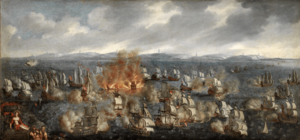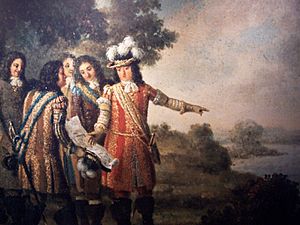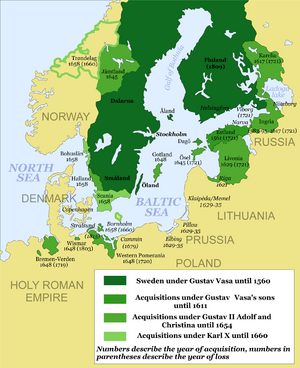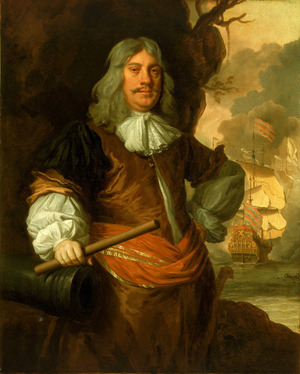Battle of Öland facts for kids
Quick facts for kids Battle of Öland |
|||||||
|---|---|---|---|---|---|---|---|
| Part of the Scanian War | |||||||
 Battle of Öland by Claus Møinichen |
|||||||
|
|||||||
| Belligerents | |||||||
| Commanders and leaders | |||||||
| Strength | |||||||
| 42 warships, including 25 ships of the line | 57 warships, including 27 ships of the line c. 12,000 men |
||||||
| Casualties and losses | |||||||
| 1 fireship at least 100 dead |
5 ships sunk 6 ships captured at least 1,400 dead |
||||||
The Battle of Öland was a huge naval battle fought on June 1, 1676. It took place in the Baltic Sea, near the island of Öland. This battle was between the combined fleets of Denmark and the Netherlands against the Swedish navy.
This fight was a key part of the Scanian War (1675–79). Both sides wanted control of the southern Baltic Sea. Sweden needed to send supplies to its lands in northern Germany. Denmark wanted to move its army to Scania in southern Sweden to start a fight on Swedish land.
As the battle began, the Swedish flagship, Kronan, suddenly sank. Almost everyone on board, including the Swedish commander Lorentz Creutz, was lost. The Danish-Dutch forces, led by Dutch Admiral Cornelis Tromp, used this confusion to their advantage. The new Swedish commander, Admiral Claes Uggla, was surrounded. His ship, Svärdet, was badly damaged in a long cannon fight. Then, a fire ship set Svärdet on fire. Uggla drowned trying to escape. With their second commander gone, the rest of the Swedish fleet fled.
Denmark won the battle, gaining control of the seas for the rest of the war. The Danish King Christian V could now send troops to Sweden. On June 29, 14,500 soldiers landed near Helsingborg. Scania became the main battlefield, with major fights like the Battle of Lund. Danish and Dutch ships were free to attack Öland and the Swedish east coast. After this defeat, King Charles XI of Sweden ordered an investigation. But no one was found responsible for the disaster.
Contents
Why the Battle Happened
Sweden's Rise and Fall
In the 1660s, Sweden was a very strong country in Europe. It had won wars against Denmark, its main rival in the Baltic Sea. Sweden gained many lands from Denmark in treaties. King Charles X even tried to completely defeat Denmark in another war.
However, other powerful countries like England and the Dutch Republic stepped in. They didn't want Sweden to become too strong. So, Charles X's plans failed. Some lands were given back to Denmark in 1660.
Denmark's Plan to Regain Lands
After 1660, Denmark wanted to get its lost lands back. King Frederick III worked to make Sweden look bad to other countries. Denmark tried to make friends with other big European powers. These included France and the Holy Roman Empire.
In 1670, France teamed up with England against the Dutch Republic. Sweden joined this group in 1672. This pushed Denmark to side with the Dutch.
The Franco-Dutch War and Sweden's Role
In 1672, French King Louis XIV attacked the Dutch Republic. This started the Franco-Dutch War. In 1674, France pressured Sweden to join the war. Sweden was promised money if it attacked France's enemies in Germany.
A Swedish army marched into Brandenburg in December 1674. They lost a small battle at Fehrbellin in June 1675. This defeat made Sweden seem less powerful. By September 1675, Denmark, the Dutch Republic, the Holy Roman Empire, and Spain were all fighting Sweden and France.
The Scanian War Begins
On September 2, 1675, Denmark declared war on Sweden. This was their chance to get back their eastern lands. The southern Baltic Sea became very important. Denmark needed to sail troops to Scania. Sweden needed to send supplies to its lands in Germany. Both wanted to control trade routes in the Baltic.
In October 1675, the Swedish fleet tried to sail out. But bad weather, sickness, and lost equipment forced them back. The fleet commander, Gustaf Otto Stenbock, was blamed. He even had to pay for the failed trip himself. In the winter of 1675–76, the fleet was led by Lorentz Creutz. But the weather was so cold that the ships were stuck in ice.
How the Fleets Were Built
Naval warfare changed a lot in the mid-1600s. Before, ships would try to get close and board enemy ships. But after the First Anglo-Dutch War (1652–54), a new tactic became popular: the "line of battle."
In this tactic, ships formed a long line. They would sail side-by-side, firing their cannons at the enemy. This meant ships needed to be very large and strong. These big ships became known as ships of the line. This new way of fighting also needed well-trained officers and large, permanent navies.
Comparing the Fleets

In 1675, Sweden had more ships than Denmark. But Sweden's ships were older and not as well kept. Their ropes and sails were often in bad shape. Swedish sailors were not as experienced as Danish and Norwegian ones. Many Danish and Norwegian sailors had worked on Dutch merchant ships.
The Danish navy had skilled leaders like Niels Juel. Plus, the Dutch sent their own ships to help Denmark. These included units led by Philips van Almonde and Cornelis Tromp. Tromp was a very experienced admiral.
Before the Battle of Öland
The Battle of Bornholm
In March 1676, a Danish fleet under Admiral Niels Juel sailed out. On April 29, they landed on Gotland island, which quickly surrendered. The Swedish fleet left port on May 19. It had 23 large warships and many smaller ones.
Juel had already left Gotland to meet a Dutch-Danish force near Bornholm. They wanted to stop Swedish troops from reaching Germany. On May 25–26, the two fleets fought an undecided battle near Bornholm. The Swedish force was bigger, but couldn't do much damage.
Tensions in the Swedish Fleet
After the Bornholm battle, Swedish commander Creutz argued with his officers. One officer said Creutz "scolded them like boys." Another said Creutz was very angry and swore he would "never to go to serve at sea with such rascals." It seems the relationship between Creutz and his officers was very bad before the Battle of Öland.
After the fight, the Swedish fleet went to Trelleborg. King Charles ordered them to recapture Gotland. He also told them to avoid fighting the allies until they reached northern Öland. This would let them fight in safer waters.
The Chase and the Weather Gage
On May 30, the Swedish fleet left Trelleborg. The allied fleet soon found them and started chasing. By now, the allies had more ships, totaling 42 vessels. They also had a new commander, Admiral General Cornelis Tromp. He was a very smart naval leader.
The two fleets sailed north. On June 1, they passed southern Öland in a strong storm. The rough winds damaged many Swedish ships. The Swedes tried to sail ahead of Tromp's ships. They hoped to get between the allies and the shore. This would give them the "weather gage," a tactical advantage. But the Dutch ships were faster. They slipped between the Swedes and the coast, taking the weather gage. Soon, the two fleets were close enough to fire their cannons.
The Battle Begins
Around noon, the Swedish line of ships suddenly turned towards the allied fleet. This was due to bad communication. As the flagship Kronan turned, it leaned over sharply. Water rushed in through its lower cannon openings.
A strong gust of wind then pushed the ship onto its side. Its masts and sails fell into the sea. Soon after, the gunpowder storage exploded. This blew apart the front right side of the ship. Kronan quickly sank, taking almost all of its 850 crew members with it.
The Loss of Svärdet
The sudden loss of Kronan and its commander caused great confusion. Four Swedish ships immediately fled. Claes Uggla was next in command. His ship, Svärdet, was on a collision course with Kronan's sinking wreckage. Uggla had to turn his ship to avoid it.
Many other Swedish ships misunderstood Uggla's turn. Some thought it was a signal to turn again. Others thought it was a signal to retreat. This caused huge disorder in the Swedish fleet. Uggla slowed down to gather his ships, but instead, he became separated from his squadron.
Admiral Tromp and other allied admirals quickly surrounded Svärdet. They also attacked three other Swedish ships. After about two hours of intense fighting, Svärdet's main mast fell. Uggla had to surrender to Tromp. But by accident, or misunderstanding, a Dutch fire ship set Svärdet on fire. The ship sank, and 600 of its 650 crew, including Admiral Uggla, were lost. Only one Swedish ship, Hieronymus, escaped. The others were captured.
The Swedish Retreat
By six o'clock that evening, Sweden had lost two major ships and two top admirals. The entire Swedish fleet began to retreat in a messy way. Smaller ships were caught and captured. The rest of the ships tried to find safety in friendly harbors. Most headed for Dalarö, north of Stockholm. Others tried to reach Kalmar Strait. The allied fleet chased them, but their own ships were spread out. The Danish commanders also disagreed on how far to chase.
What Happened After
Danish Control of the Sea

The Swedish fleet suffered a huge defeat. They lost their two biggest ships and their main commanders. Even after the battle, problems continued. The ship Äpplet broke free from its moorings, ran aground, and sank. About fifty survivors were captured by Danish ships.
This battle gave Denmark full control of the sea. The Swedish fleet did not dare to sail out for the rest of the year. The Danish army could now be sent to Scania. On June 29, 1676, 14,500 Danish troops landed near Helsingborg. The Battle of Öland was the first major Swedish naval defeat to Denmark. More Swedish defeats followed in 1677.
The war taught Sweden important lessons. Their main naval base in Stockholm often froze in winter. This showed they needed an ice-free harbor closer to Denmark. In 1679, King Charles chose a new site for a base. This became the city of Karlskrona. Sweden also improved its navy after the war. They got better funding, maintenance, and trained more sailors.
The Swedish Investigation
News of the defeat quickly reached King Charles. He immediately ordered an investigation. He wanted to know if officers were cowards or simply bad at their jobs. The King said some officers showed "cowardly and careless behavior." He believed such a serious crime should be "severely punished."
The investigation began on June 7, 1676. Officers openly criticized each other. One officer said his colleagues acted like "chickens running about the yard." He added that he had been in many battles but "had never seen our people fight so poorly."
In the end, the investigation didn't find anyone guilty of being negligent. However, some officers were never given command in the navy again. Historians often blame Lorentz Creutz for the loss of Kronan. They say he was not good at leading ships. But some historians say his job was more about managing, not sailing. They believe his experienced officers should have handled the ship's movements.
Disagreements Among Allied Officers
Even with their victory, some allied officers were not happy. Naval historian Jørgen Barfod said the battle was "disorganized from beginning to end." Admiral Tromp had told commanders to attack the closest enemy ship. But many Danish ships couldn't keep up with the faster Dutch ships.
Admiral Juel later complained that the Dutch didn't help him chase the fleeing Swedes. He felt they could have caused even more damage to the Swedish fleet. When Tromp reported to the Danish King, he criticized his officers. But he asked that no one be punished.
The captain of the fire ship that burned Svärdet was arrested. He was treated so harshly that he died within days. Tromp also reported that his ship, Delft, had lost about 100 men. Most of its officers were wounded.
Ships in the Battle
Below is a list of the ships that fought in the battle. The numbers in parentheses show how many cannons each ship had.
Allied Fleet ShipsFirst Squadron
Second Squadron
Third Squadron
|
Swedish Fleet ShipsFirst Squadron
Second Squadron
Third Squadron
Fourth Squadron
|




